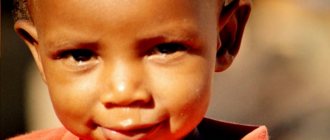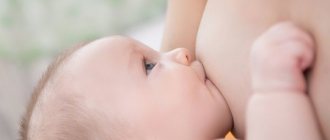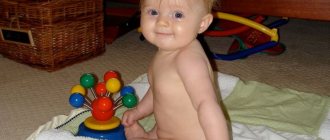Every good mother dreams of knowing everything about her child. However, in most cases, it happens that the baby does not want to talk about all the events that happen to him. How can you tell if he has any problems, desires, or fears? Is your child bullied in kindergarten? His sleep position will help you get more information about what is bothering your child.
To carry out this observation, there is no need to change anything in his daily routine, in particular, his quiet time. After all, you need to find out what’s in his soul. And if something bothers him, try to find the reason for it and fix everything.
If the baby sleeps spread out on the bed
The baby sleeps on his back, often in the center of the bed, with his legs spread out in all directions. Hands in a dream are in constant motion: the baby either lifts them up, then presses them to the sides, placing them parallel to each other, or even spreads them out to the sides. The hands are not tense, the baby sometimes even moves his fingers.
This position shows that the child is not experiencing any trouble, so you have no reason to worry. He feels protected and calm when communicating with others. Such a child decisively overcomes both difficulties and joys and is not afraid of any changes in life. If he sleeps in this position, then he is open and confident. And if the arms are not just raised, but also slightly bent, then your baby is truly happy and probably in a dream once again sees everything pleasant that happened to him over the last day.
However, if he clenches his fists in this position, this is not a very good sign. If at the same time as his clenched fist his thumb is pointed outward, it means he is showing hostility and defending himself. And if the thumb is hidden in a fist, he, on the contrary, feels in danger and cannot protect himself. Parents need to find out what is the reason for his worries. This could be a bad relationship both in the family (are you too strict with him?) and with peers.
Optimal position for baby during sleep
As a rule, infants can sleep in 3 positions - on their tummy, on their back and on their side. Of course, during rest the child can turn, throw back his head, move his arms and legs.
However, responsibility for how the baby rests lies entirely with the parents. That is why it is necessary to take special care when placing a baby, who should sleep only in safe positions. You need to constantly monitor your baby while he sleeps and, if necessary, adjust his position.
Threatening poses
All those body positions during sleep when the spine takes on an unnatural appearance can harm the baby’s health. This could be an overly thrown back head, a strongly bent back. Such postures will create incorrect posture and can cause the development of scoliosis.
Attention! Sleeping on the stomach is especially dangerous for a baby: the baby may bury his nose in a blanket or sheet, and oxygen access will be difficult. This situation will become especially threatening if there are folds on the bed. In this case, sleeping on your stomach can be fatal.
A child can sleep in this position only if he is under the constant supervision of his family. In other cases, it is better not to take risks.
Favorable Positions
The most comfortable and correct positions for a baby are sleeping on the side or on the back. But they also have their own characteristics.
You can put your baby to sleep on his back only after the baby has eaten and burped. Otherwise, he risks choking on his burp. Also, this position is not very good; if the baby has a runny nose, the baby will have difficulty breathing. If you take these features into account, then this pose is the most physiological and will help form a healthy spine.
Sleeping on the side is good because the child is not afraid of vomit and mucus in the nose; in this position they will not cause harm to health. The only inconvenience is that the baby can fall forward or backward, and this is fraught with problems with the musculoskeletal system. To prevent this from happening, it is recommended to use special support pillows.
Sleeping in a stroller
If for some reason the child is resting in a stroller, then he should only be placed on his back in a horizontal position. Sleeping half-sitting is unacceptable, since the baby's spine is not yet developed, the child may fall on his side, which in turn will lead to negative health consequences.
Relaxing with mom
Many parents are afraid that while resting in the same bed with their child, they may accidentally crush him or cause him pain. Some pediatricians speak negatively about mother and baby sleeping together, since subsequently it will not be easy to teach the baby to sleep alone. Staying in the same bed with your parents at night has many benefits: it strengthens the bond between all family members, the baby becomes calmer, and it makes it easier for the mother to breastfeed.
In order for a joint vacation to evoke only pleasant emotions and not harm the health of the newborn, it is important to adhere to the following rules:
- The mother must be healthy and not drink alcohol or sedatives.
- The sleeping area should be hard and level. A soft mattress and pillow placed specifically for a baby can provoke curvature of a fragile spine.
- It is important to observe the temperature regime. It is harmful to wrap a baby up and create drafts.
- The optimal place to sleep is the middle of the bed or an area near the wall. If the child lies on the edge, there is a high risk of falling.
- The optimal sleeping position is on your side, as babies often spit up after breastfeeding. When lying on the back, there is a high risk that the baby may choke.
If you follow the above recommendations, spending time together between mother and baby will bring a lot of positive emotions to both of them and will help strengthen their bond.
Baby sleeps on his stomach
The baby sleeps on his stomach, with his arms and legs stretched out to the sides. It seems as if he wants to capture as much territory as possible. This pose speaks of his touchiness and even vulnerability. He is unable to protect himself and needs someone who can do it. Such a child does not like big changes in life, and if they happen to him, then he needs time to prepare for the upcoming changes. Often children of this type hide all their emotions within themselves, because they do not trust other people.
If, on top of everything else, he lay down on the bed at a certain angle, trying to capture it entirely, then the desire to control everything manifests itself even more clearly. We can say about this kid that he is trying as best he can to resist important changes in his life.
Interesting read: teaching your baby to fall asleep on his own.
In this case, mothers and fathers should, as far as possible, simplify the child’s life. Maybe it won’t be so bright, but, most importantly, it will be comfortable and convenient for him. It is advisable to inform the child in advance about upcoming events, be it a trip to the store or the arrival of guests. And don't scold him if he expresses his emotions. Expressing feelings is a need for all people, and especially children.
On the side
The lateral position is considered the safest and most optimal for a newborn. Many experts consider this to be the best sleeping position for a newborn. However, the possibility of the baby turning onto his stomach should be excluded. To do this, gently place a special orthopedic cushion or a regular towel rolled into a sausage under the back of a small child.
The main advantage of this position for sleeping a newborn, the photo of which is presented above, is that the baby, lying on his side, presses his legs to his tummy, which ensures the safe passage of gases and improved digestion.
Parents should understand that lying on the side increases the load on the baby’s pelvic bones. It is strictly prohibited for newborns and babies up to three months inclusive with hip dysplasia to sleep in this position.
In addition, the baby's arms are free on the side. This is why a baby can easily scratch himself. To avoid such consequences, it is enough to wear a vest with sleeves or use sleeves separately. You can purchase a special wardrobe item at almost any children's goods store.
Sleeping frog pose - what does it mean?
If your child does not sleep as usual, with his face buried in the pillow and his butt and back raised up, in other words, in the frog position, then he probably does not agree with something or someone. The subject of this disagreement can be serious, especially if your baby has clenched his fists. Listen carefully to him, and perhaps you will be able to resolve this problem. But here you don’t always need to look for a significant reason; maybe he just didn’t want to go to bed at such an early time?
Acceptable positions for a newborn during sleep
Older children, from about 4 months, choose their own sleeping position. But newborns are in the “land of dreams” in the position that their parents chose for them.
The natural body position for a baby is the frog pose, in which a small child lies on his back, with his arms slightly bent at the elbows, legs at the knees, and his head turned to the side. In addition, the baby can be placed on his tummy or on his side. We need to say a few words about the benefits of different baby body positions in order to choose the optimal sleeping position for a newborn.
Baby sleeps in fetal position
The position of a sleeping baby resembles the fetal position. The legs are tucked under the head, as close to the chin as possible. The arms can clasp the legs or be placed under the head. Sometimes a child can completely cover himself with a blanket.
This position suggests that the child has some problems that he cannot solve himself. And the more curled up he is in the crib, the more trouble he gets into. A blanket covered over the head indicates that only there, in a kind of fortress, does the baby feel calm. Moreover, if he sleeps this way near the wall, then he worries about himself. Perhaps not everything is working out as it should in his relationships with his peers. But if he sleeps at the very edge, then he is worried about his family or other people close to him. If in a dream your baby hugs his shoulders, then this indicates that he is not used to talking about his desires, needs and troubles.
Seeing their child in this position, parents should do something. He is too vulnerable and simply needs protection. The baby's family should show the necessary care and pay as much attention as possible. There is no need to enroll him in kindergarten ahead of time; on the contrary, this should be done as late as possible. Problems may arise in communicating with other people, so try to limit him from this. Such children should know that they are always loved, valued and protected.
In conclusion, I would like to note that reading the inner world of a child by his posture is very conditional. Moreover, this method is not applicable for children under two years of age. In some cases, postures are determined by congenital characteristics and can persist in children up to 6 years of age. In this case, you should have no reason to worry.
Posture and character
During sleep, our brain and body are inextricably linked, so body language is the guiding language. It is he who can tell about the peculiarities of our behavior in certain situations, character traits and even moods. And very often the information is completely different from what we perceive consciously. Our body language, which includes facial expressions and gestures, conveys more than 80% of the information to others, and it is determined by subconscious impulses that cannot be controlled. Therefore, many psychologists, for example Freud, Dunkell, Carnegie, conclude that the sleeping position not only best conveys a person’s character, but also signals his psychological state.
Find out how to fall asleep quickly and learn how to get enough sleep.
The position of the embryo can indicate that the person is very closed. He cannot allow himself to open up to new events in life and the world, accept both bad and good, and most often does not use the full potential of life and does not gain experience. Often a person sleeps on the edge of the bed, facing away from the wall. This body position sends a signal that he really needs support and tenderness, approval and affection. Perhaps he needs protection and support in some matters. They are looking for her in the person of a family, a loving life partner, children. This line of behavior is formed in childhood, when parents provided the necessary safety and comfort, and is transferred to later years, into adulthood.
Did you know? The fetal position is often chosen by infantile people. Their character is characterized by uncertainty, dependence on other people's opinions and delegation of responsibility for their lives to others. Very often such people try to meet the expectations of others.
People who sleep almost constantly in the fetal position:
- Dependent on their environment.
- Life is built around key figures from whom they receive support, love and approval (partners and family).
- They look determined on the outside, but are very vulnerable at heart.
- Very closed and distrustful.
- It is difficult for others to open up, this is due to a lack of trust in people.
Such a person lacks leadership qualities and will never take risks. Often such people have big problems with self-realization. They are always reserved and like to be alone with their thoughts. If the knees are not bent very much, then the character has such traits as honesty, balance, a stable psyche and a good attitude towards others. Those who like to sleep this way have a practical mindset.
Choosing a sleeping position
The child can lie either on his back or on his tummy. In addition, a position on its side may also be a comfortable position for the baby. But it all depends on whether this or that position is really suitable in a particular case. After all, the main thing is to follow safety precautions, otherwise the outcome can be very different, even fatal.
Parents should also take care of the room where the baby sleeps. It is strongly recommended to ventilate the room as often as possible. The room temperature should vary from 20 to 23°C, and the humidity from 65 to 70%. The child's sleeping place must be of medium hardness, level and smooth. To make sure whether this mattress is suitable for a baby, you need to put your little one on it. If after a few minutes of being on it the surface has not changed (that is, there are no various kinds of deflections), the bed is really of high quality.
There should be no bright lighting in the room, sound insulation is desirable. It is better to have twilight in this room so that the child’s eyes gradually adapt to the environment. In addition, it is strongly recommended to turn off the sound on phones so that the sudden loud screams of some singer do not disturb the baby’s sleep. There should be no electrical appliances in the room.
On the back
The sleeping position for a newborn on his back is the most common and safest. With this position of the baby’s body, the head is turned on its side, and the risk of choking as a result of regurgitation is minimized.
Parents strictly need to alternate the sides in which the baby’s head is turned while in a horizontal position. This is necessary in order to prevent the risk of the occurrence and further development of problems with the baby’s musculoskeletal system, including torticollis, a fairly common disease that occurs in young children under the age of one year.
This sleeping position is not suitable for babies with hip dysplasia. For them, the most acceptable position is on the tummy. In addition, experts strongly recommend that parents of babies who suffer from digestive problems and have difficulty passing gases avoid sleeping on their tummy. The latter situation can be resolved with the help of a heating pad or a warm diaper.
Negative aspects
A person sleeping in the fetal position is similar to a baby in the womb. It is the most natural, since we are in this position even before we are born. However, despite the physiology, there are also negative aspects to the embryonic position. Let's look at some of them:
- Load on the spine. The person is in a hunched position that is unnatural for the back.
- The appearance of pain in the back and neck. When you sleep in the fetal position, the joints at the base of the skull are compressed.
- Compression of the diaphragm. The bent condition limits normal diaphragmatic breathing.
- Compression of the internal organs occurs by pressing the knees to the chest.
- Poor blood circulation in the extremities due to bent legs that remain in this position for a long time.
- Sleeping on your side can cause wrinkles on the side of your face that rests on the pillow. Also, in women, due to the fetal position, folds on the chest appear faster.
pros
Osteopaths recommend lying in the fetal position for a good night's sleep. This position gives the spine enough flexibility to move throughout the night. If a person suffers from hypertension (high blood pressure), it is recommended to lie on the right side. In this position, the heart is not compressed, the load on it is reduced and the heart rate slows down. The pressure should therefore decrease.
Sleeping on your side is good for your brain. It is believed that a person in the fetal position while sleeping on the left or right side improves the cleansing of the tissues of the brain and spinal cord. The glymphatic system, which is responsible for removing unnecessary substances, works more efficiently in this position. Thus, people who sleep in the fetal position have a reduced risk of Alzheimer's disease and other neurodegenerative diseases.











